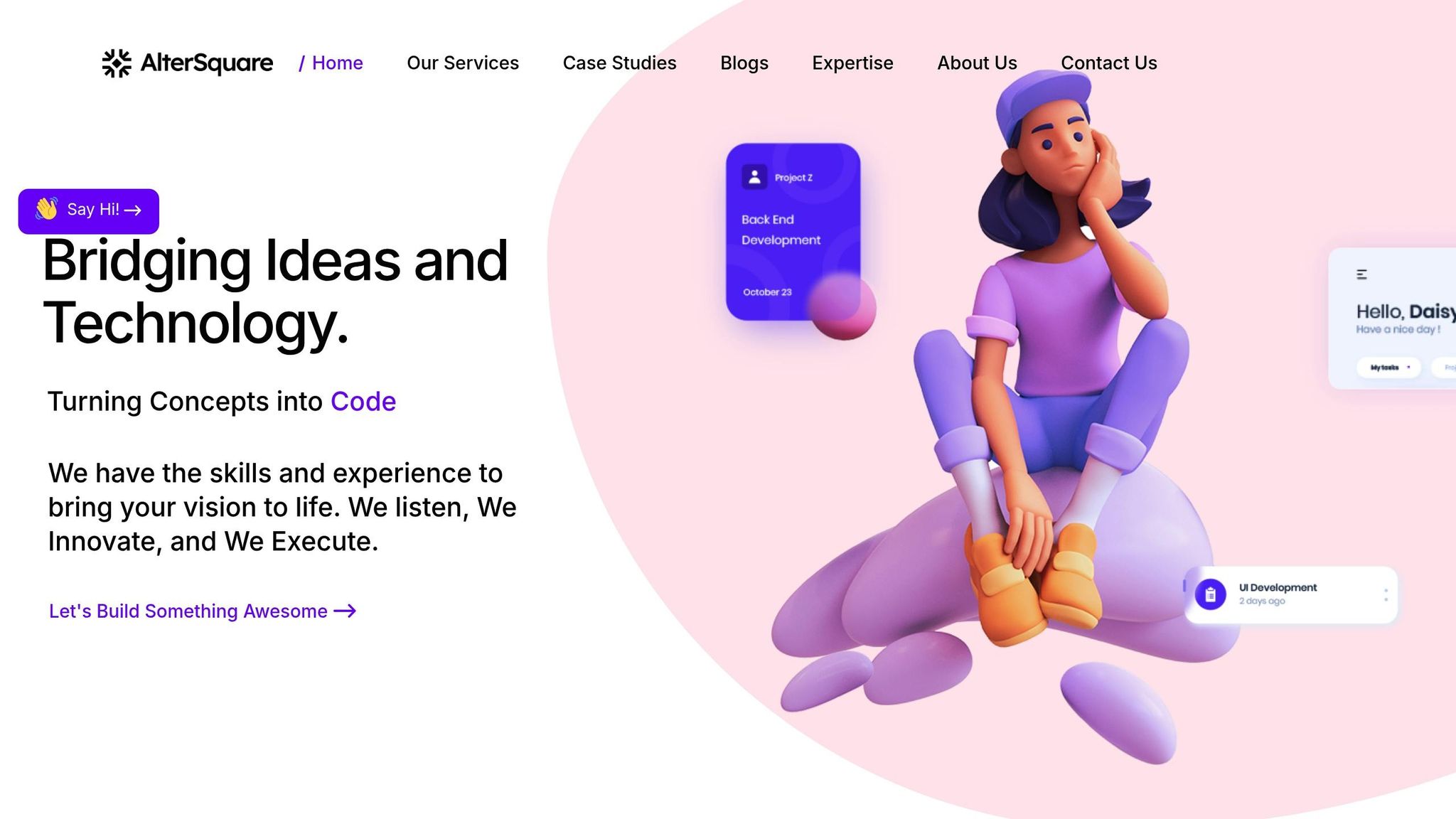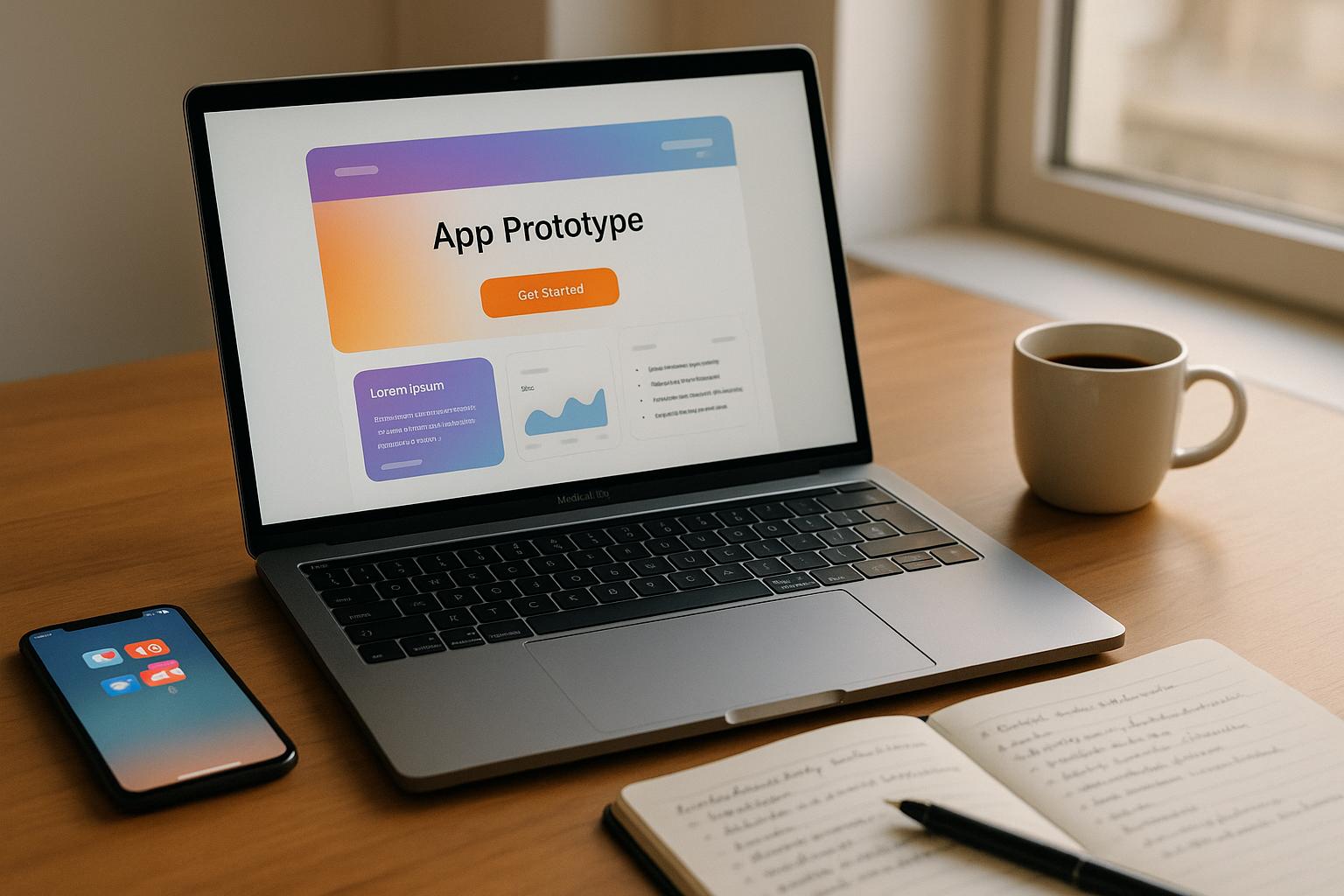The Great Developer Arbitrage: How Smart Founders Build 3x Faster for Half the Cost
Taher Pardawala November 4, 2025
Building a startup product is expensive, but there’s a smarter way to save time and money. Developer arbitrage lets you hire top-tier engineers from regions with lower costs, delivering the same quality at a fraction of the expense. By leveraging global talent and AI tools, startups can build products three times faster while cutting costs in half.
Key Takeaways:
- Save Money: Hire skilled developers from regions like Eastern Europe, Latin America, and Southeast Asia for $40,000–$80,000/year instead of $200,000+ in the US.
- Speed Up Development: Use overlapping time zones and AI tools like GitHub Copilot and Testim.io to accelerate workflows.
- Build Lean Teams: A small team of 3–5 experts can deliver faster results than a bloated team.
- AI Integration: Automate coding, testing, and design to reduce manual tasks and improve efficiency.
This approach is transforming how startups operate, making quality development faster and more affordable than ever.
MVP Success Formula: What I Learned from 100+ Launches
Finding High-Quality Developers at Lower Costs
Hiring talented developers from lower-cost regions can be a game-changer for startups looking to balance quality and budget. But success requires more than just posting a job ad. You need a thoughtful approach to sourcing, evaluating, and onboarding.
Where to Find Top-Tier Talent
Certain regions consistently stand out for providing skilled developers at competitive rates:
- Eastern Europe: Countries like Poland, Ukraine, Romania, and the Czech Republic boast developers with strong technical education and experience. Their rates are competitive, making this region a popular choice for quality talent.
- Latin America: For U.S.-based startups, Argentina, Colombia, and Mexico offer a great mix of time zone alignment, cultural similarities, and strong English proficiency. These factors make real-time collaboration smoother and more efficient.
- South Asia: India and Pakistan are known for their vast pool of skilled developers. While time zone differences can be a hurdle, these regions are ideal for projects requiring round-the-clock development.
- Southeast Asia: Countries like the Philippines and Vietnam are emerging as strong contenders, offering a balance of technical skills, good English proficiency, and reasonable time zone overlap with U.S. operations.
By tapping into these diverse talent pools, you can find the right fit for each role while keeping costs in check.
How to Evaluate Developers for Quality and Fit
Hiring the right developer goes beyond technical expertise. In fact, 70% of employers now prioritize practical skills over formal degrees when evaluating candidates [2]. Here’s how to assess developers effectively:
- Focus on Real-World Scenarios: Practical assessments are more telling than abstract coding challenges. For example, if you’re building an e-commerce platform, ask candidates to design a simple cart system. For a SaaS product, have them create a basic user authentication flow.
- Assess Architectural Knowledge: To differentiate senior developers from juniors, ask about design decisions they’ve made in past projects. Look for insights into how they handled scalability, security, and maintainability.
- Check Open-Source Contributions: Developers active in open-source projects or tech communities often showcase strong problem-solving and collaboration skills. Research shows that 45% of such developers perform better in these areas [2].
- Use Paid Trial Projects: These are invaluable for evaluating how candidates tackle real tasks, communicate progress, and handle feedback.
- Interview for Communication Skills: Look for candidates who can clearly explain technical concepts and aren’t afraid to ask clarifying questions. A lack of questions during an interview can be a red flag [2].
- Gauge Cultural Fit: Cultural alignment is critical, especially in startups. Companies with strong cultural alignment see 30% higher employee retention rates [2]. Look for developers who thrive in ambiguity, solve problems proactively, and adapt quickly to change.
In fact, 88% of hiring managers believe past job performance is the best predictor of future success [2].
| Vetting Aspect | Best Practices |
|---|---|
| Technical Skills | Hands-on coding tests, portfolio reviews, open-source contributions, architectural discussions [1][2] |
| Cultural Fit | Video interviews to assess adaptability, problem-solving, and alignment with company values [1][2] |
| Communication | Strong English skills, clarity, ability to explain concepts, and asking thoughtful questions [1][2] |
| Collaboration | Paid trial projects, remote collaboration style, and time zone compatibility [1][2] |
Managing Time Zones and Communication
Working across time zones requires careful planning to ensure smooth collaboration. Teams with a three- to five-hour overlap in working hours tend to collaborate more effectively [2]. Here’s how to make it work:
- Daily Overlap: Aim for at least three to four hours of overlap to handle stand-ups, quick problem-solving, and coding sessions. Tools like World Time Buddy can help visualize overlapping hours during the hiring process.
- Asynchronous Communication: For times when team members aren’t online simultaneously, clear protocols are essential. Developers should excel at documenting their work, whether through detailed pull request descriptions or updates in project management tools.
- Regular Stand-Ups: Short daily meetings during overlapping hours help keep everyone on the same page and address issues before they escalate [2].
- Bridge Cultural Differences: Communication styles can vary by region. While some cultures prefer direct communication, others rely on context. Establish shared guidelines to avoid misunderstandings and foster a cohesive team dynamic.
Building a documentation-first culture is another smart move. Recording key decisions, architectural plans, and project requirements creates a knowledge base that supports the team as it scales.
Although managing distributed teams demands extra effort, the rewards – access to global talent, cost savings, and often higher productivity – make it well worth the investment.
Building Teams for Maximum Efficiency
Once you’ve secured top-notch talent, the next challenge is assembling a focused team that can streamline your MVP development process.
Creating a Lean MVP Team
A lean MVP team typically includes 3–5 core members. This setup often consists of 1–2 full-stack developers who can handle both frontend and backend tasks, a UI/UX designer to ensure the product is user-centric, and a product manager to oversee priorities and maintain quality. Bringing in a DevOps specialist can wait until after the product has been validated.
Having a cross-functional team minimizes silos and speeds up decision-making. With the right mix of skills, agile sprints and timely feedback can drive development forward at a rapid pace.
Agile Sprints and Feedback Loops
Proper sprint planning is essential, especially for distributed teams. Poor planning is a major hurdle, with 67% of teams citing it as a key productivity blocker [3]. On the other hand, teams that adopt structured planning processes for distributed work see a 35% boost in story points delivered [3].
To stay ahead, prepare backlog items at least two sprints in advance. Rigorous backlog grooming with clear templates and defined acceptance criteria becomes even more critical when working across time zones. Planning meetings should be concise and focused, ideally scheduled during a 3-hour overlap to finalize commitments and address dependencies [3]. For teams with limited time zone overlap, asynchronous pre-planning – like submitting capacity estimates and initial story selections – can improve efficiency.
Feedback loops in distributed settings require careful structuring. Tools that provide visual management and facilitation techniques, such as directed questioning, can help ensure equal participation across locations [3]. Structured retrospectives, which start asynchronously and transition into focused discussions, can reduce sprint disruptions by 45% [3].
| Team Structure Component | Optimal Configuration | Key Benefits |
|---|---|---|
| Core Development | 1–2 full-stack developers with 3+ years of experience | Flexibility, streamlined communication, quicker iterations |
| Design & UX | 1 UI/UX designer with startup experience | User-centered design, fast prototyping |
| Product Management | 1 product manager who also handles quality assurance | Clear direction, stakeholder alignment, consistent quality |
| Sprint Duration | 1–2 weeks with structured planning | Faster feedback, improved predictability, lower risks |
Teams that carefully choose the right tools for distributed agile processes report a 27% increase in team satisfaction [3]. Additionally, organizations that implement effective distributed strategies see a 15–25% improvement in sprint planning efficiency [3]. Building the right team structure and processes is an investment that pays off throughout the product development cycle.
sbb-itb-51b9a02
Using AI-Driven Tools to Speed Up Development
Pairing developer arbitrage strategies with AI tools has become a game-changer for boosting productivity and cutting down time to market. Artificial intelligence is reshaping how development teams tackle coding, testing, and deployment. Founders who embrace these tools can speed up development timelines without sacrificing quality.
AI Tools for Coding and Design
AI-powered coding tools have come a long way. Take GitHub Copilot, for example – it’s widely recognized for assisting with automated code completion and offering smart suggestions. Integrated into popular IDEs like Visual Studio Code, it helps developers write functions, solve complex algorithms, and even generate code from natural language prompts. This frees developers to focus on broader architectural decisions.
On the design side, Figma’s AI capabilities simplify tasks like auto-layout and component generation, making UI/UX design more efficient. Combine this with Framer’s AI website builder, and teams can quickly turn ideas into interactive prototypes, significantly shortening the design process.
When it comes to documentation, tools like Mintlify and GitBook’s AI assistant take the heavy lifting out of creating API docs, inline comments, and technical specifications. By automating these traditionally time-consuming tasks, developers can dedicate more energy to building and refining their core features.
Testing automation has also seen a boost from AI. Platforms like Testim.io use machine learning to create test suites that adapt to UI changes, reducing the manual effort needed for test maintenance. Together, these tools help streamline the entire development pipeline, from design to deployment.
Improving Development Workflows
AI tools are becoming a natural fit within established development workflows in the US. For instance, GitHub Actions now includes AI-driven code reviews that spot issues and optimize code while seamlessly integrating with Git workflows.
Project management tools are also stepping up. Jira’s AI features can categorize tickets, estimate story points, and flag potential blockers, making task management more efficient. On top of that, Slack’s workflow automation, when paired with AI, keeps teams in sync by sending real-time updates on code deployments, test results, and performance metrics – perfect for distributed teams working across time zones.
AI-powered project tracking tools add another layer of efficiency by predicting delivery timelines and dynamically adjusting schedules as project scopes evolve. This makes it easier for founders to set realistic expectations with stakeholders and adapt to changes without derailing progress.
Standard Development vs. AI-Augmented Development
Traditional development workflows often feel slow and labor-intensive, with each phase requiring significant time and effort. AI-augmented development flips the script, streamlining processes and delivering faster results while minimizing post-deployment issues.
The best part? Developers can quickly adapt to these tools. They don’t require extensive retraining, as the tools are designed to complement existing skills. This makes AI tools a practical and powerful way to speed up development and improve outcomes.
Case Study: How AlterSquare Helps US Startups Build Faster and Cheaper

Let’s dive into how AlterSquare is helping US startups streamline their development processes while cutting costs, all without sacrificing quality.
AlterSquare specializes in providing startups with cost-efficient teams and AI-powered tools that make product development faster and more affordable. Their approach focuses on delivering results that are both efficient and high-quality.
AlterSquare’s Developer Arbitrage Model
AlterSquare operates on an engineering-as-a-service model, essentially becoming an extension of your business. Based in Mumbai, they deliver top-tier code and user experiences at a fraction of what it would cost domestically.
Their process is built around a structured framework called I.D.E.A.L., which includes:
- Discovery & Strategy: Laying the groundwork for the project.
- Design & Validation: Ensuring concepts are user-friendly and feasible.
- Agile Development: Building the product iteratively for flexibility.
- Launch Preparation: Getting everything ready for go-live.
- Post-Launch Support: Providing ongoing assistance after release.
This framework ensures projects are not only cost-effective but also well-managed and high-quality. Their team is skilled in modern technologies like Vue.js, Nuxt.js, GoLang, and Node.js, enabling them to develop scalable, enterprise-grade applications. By incorporating AI and generative-AI tools, they speed up development and reduce the manual effort required for complex tasks.
Additionally, AlterSquare supports founders – especially those without technical expertise – by offering CTO-level guidance. This ensures startups can make smart decisions about their product development while keeping the vision intact. The mix of hands-on development and strategic advice helps distributed teams stay aligned and focused on delivering impactful results.
Results from Real Projects
AlterSquare’s 90-day MVP program, starting at $10,000, is a prime example of their efficiency. It delivers market-ready products at three times the speed and cost savings typical of their developer arbitrage model.
For instance, they stepped in to rescue a struggling US SaaS project by quickly delivering critical features. This not only helped the startup stabilize but also boosted revenue and customer satisfaction.
Their AI-driven solutions have been game-changers for tech-savvy businesses. By integrating generative AI, chatbot automation, and custom machine learning models, they’ve helped startups automate labor-intensive workflows, freeing up resources for other priorities.
For growth-stage startups, AlterSquare’s tech team augmentation services provide the flexibility to scale development efforts without the overhead of full-time, in-house teams. These real-world results showcase how their approach translates into measurable benefits for US startups.
Why AlterSquare Works for US Startups
AlterSquare’s success lies in their commitment to quality, clear communication, and their ability to align with US startup needs. Their approach complements the agile, globally-sourced strategies that many startups rely on today.
Their integrated product management ensures technical work aligns with business goals. They tackle communication challenges with continuous feedback loops and agile delivery methods. Plus, their teams are structured to overlap with US time zones, enabling real-time collaboration when needed.
They also understand the fast-paced demands of US startup culture, from rapid iteration to investor updates and market validation. Their phased delivery framework accommodates these needs, offering milestone-based progress tracking and flexibility to adapt based on user feedback.
AlterSquare doesn’t just focus on the short term. Their architecture modernization services address technical debt and ensure scalability, so startups don’t face roadblocks as they grow. By planning for the future, they make sure cost-effective MVPs won’t cause headaches down the road.
With a combination of proven processes, cutting-edge technology, and a deep understanding of the US market, AlterSquare has become a go-to partner for founders looking to implement developer arbitrage strategies with confidence and reduced risk.
Conclusion: Taking Action with Developer Arbitrage
Developer arbitrage has the potential to reshape how startups operate, offering a way to build products three times faster while cutting costs significantly. By strategically sourcing talent, maintaining lean yet effective teams, and leveraging AI tools, startups can achieve speed, cost savings, and quality all at once.
Key Takeaways
- Tap into global talent pools: Look for skilled developers in regions with strong technical education systems and overlapping time zones. This ensures both quality work and smooth collaboration.
- Prioritize team structure over size: A small, focused team of experienced developers often outperforms a larger, less organized group. Build your teams around specific deliverables, use agile sprints with clear feedback loops, and implement phased delivery to keep projects on track.
- Leverage AI tools: Incorporate AI-powered coding assistants, automated testing frameworks, and intelligent design tools into your workflow. These tools can save time on repetitive tasks while improving code quality and consistency.
- Streamline distributed team collaboration: Use tools that enable seamless communication, set clear documentation standards, and schedule overlapping work hours to enhance real-time problem-solving.
These strategies provide a clear path to optimize your development process and make the most out of developer arbitrage.
Next Steps for Founders
- Audit your current development process: Take a close look at your costs and timelines to identify areas where developer arbitrage could make an impact.
- Start small with a pilot project: Test the waters by applying these strategies to a non-critical feature or a new product module. This approach helps you refine your methods before scaling up.
- Evaluate and select the right talent: Create technical assessments, conduct communication tests, and offer small paid trials to ensure you’re hiring developers who meet your quality standards and align with your company culture.
- Integrate AI tools gradually: Begin with essentials like code completion and automated testing, then expand as your team becomes more comfortable with advanced solutions.
- Consider expert partnerships: Partnering with services tailored to startups can fast-track your efforts. For instance, AlterSquare’s 90-day MVP program, starting at $10,000, provides a structured approach to quickly deliver market-ready products while managing costs.
Speed and efficiency are critical in the competitive startup world. Developer arbitrage offers a strategic way to achieve both – so don’t wait. The sooner you act, the better positioned you’ll be to stay ahead of the competition.
FAQs
How can startups maintain high-quality standards when hiring developers from more affordable regions?
Startups can achieve excellent results when hiring developers from regions with lower costs by following a few smart strategies:
- Conduct a rigorous vetting process: Dive deep into candidates’ technical skills through detailed assessments, portfolio evaluations, and live coding sessions to ensure they meet your standards.
- Prioritize clear communication: Lay out expectations, project timelines, and deliverables from the start to prevent any confusion or misaligned goals.
- Leverage collaborative tools: Use tools like project management platforms and communication apps to keep workflows smooth and maintain transparency across the team.
By sticking to these principles, startups can assemble dependable teams that deliver quality work while keeping costs manageable.
What are the best ways to manage a remote development team working across multiple time zones?
Managing a remote team spread across time zones can feel tricky, but with the right approach, it becomes much easier. Start by setting core overlap hours – a specific window when most team members can connect for meetings or quick discussions. This ensures everyone has a chance to touch base in real time.
At the same time, lean into asynchronous communication. Tools like project management platforms or team collaboration apps allow everyone to contribute at their own pace without missing a beat. It’s about keeping everyone on the same page, even if they’re working different hours.
Make sure to outline clear expectations for availability. Let your team know when they need to be reachable and through which channels. To keep things fair, consider rotating meeting times so no single group always deals with the time zone challenges.
Lastly, remember to be aware of cultural differences and encourage open dialogue. Fostering an environment of understanding and collaboration will strengthen your team’s connections and keep productivity high, regardless of where they are in the world.
How can startups use AI tools to boost productivity in their development process?
AI tools are transforming how startups operate by taking care of repetitive tasks, enhancing code quality, and making team collaboration more seamless. Tasks such as code formatting, test generation, and documentation creation can be handled by these tools, freeing up developers to tackle more complex challenges and focus on innovation.
These tools also boost code quality by catching errors as they happen and providing smart, actionable suggestions. They simplify workflows by making code reviews easier and speeding up the onboarding process for new team members. When used effectively, AI tools can help startups speed up development cycles while ensuring top-notch quality in their work.








Leave a Reply